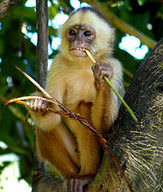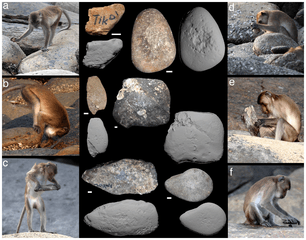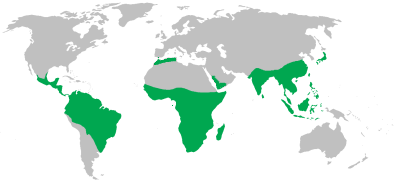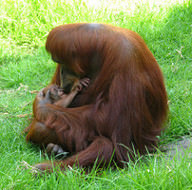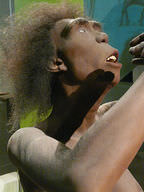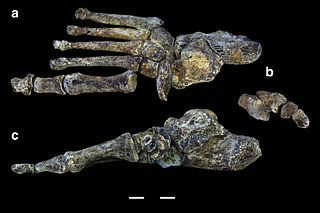2.5 《人类动物》
Section outline
-
Primate Pals
::名 生 子 子 子 子 子 子 子 子 子 子 子 子Humans belong to the , which includes small organisms — like — and larger organisms, like humans and monkeys. From genes to morphology to behavior, humans and monkeys are similar in many ways because they share an evolutionary past. Humans and monkeys also both belong to the o rder Primate, which means they have more traits in common with each other than with insects.
::从基因到形态到行为,人类和猴子在许多方面是相似的,因为他们有着进化的过去。 人类和猴子都属于Primet秩序,这意味着它们比昆虫具有更多的共同特征。How Humans Are Classified
::人类如何被分类You probably know that modern humans are members of the Homo sapiens . But what is our place in nature? How is our species classified? A simple is represented in the taxonomic diagram , along with some representative characteristics.
::你可能知道现代人类是智人的成员。但我们在自然界中的位置是什么?我们物种是如何分类的?一个简单的例子在分类图中都有代表,还有一些具有代表性的特征。This taxonomic diagram shows how our Homo sapiens species is classified.
::这个分类图显示了 我们的智人种是如何被分类的Let's start at the bottom of the chart, with the kingdom. Among other animal characteristics, humans can move on their own, so they are placed in the animal kingdom. Further, humans belong to the animal phylum known as , because we have a backbone . The human animal has hair and milk glands, so we are placed in the class of mammals . Within the mammal class, humans are placed in the primate order.
::让我们从图表的底部开始,从王国开始。除了其他动物特征外,人类可以自己行动, 因此他们可以被安置在动物王国。 此外,人类属于动物植物, 因为我们有脊椎。人类动物有毛发和乳腺, 因此我们被安置在哺乳动物类中。在哺乳动物类中,人类被置于灵长类中。Humans as Primates
::人类作为原始人Living members of the primate order include monkeys, apes, and humans. Any member of this order of mammals is called a primate. At some point in the distant past, we shared ape-like ancestors with all of these modern groups of . We share between 93 and 99 percent of our sequences with them, which provides hard evidence that we have relatively recent common ancestors. Besides genes, what traits do we share with other primates?
::灵长类动物的活成员包括猴子、猿类和人类。哺乳动物的任何成员都被称为灵长类动物。在遥远的过去某个时候,我们与所有这些现代群体分享了类猿祖先。我们与他们分享了93%至99%的序列,这提供了我们最近拥有相对共同祖先的确凿证据。除了基因外,我们与其他灵长类动物分享什么特征?Primates are considered generalists among the mammals. A generalist is an organism that can thrive in a wide variety of environmental conditions. Generalists also make use of a variety of different resources; for example, they consume many types of food . Although primates exhibit a wide range of characteristics, there are several traits shared by most primates.
::灵长类动物在哺乳动物中被视为通俗主义者,通俗主义者是一种可以在多种环境条件下蓬勃发展的有机体,通俗主义者还利用各种不同的资源,例如,他们消费多种食物。 尽管灵长类动物具有多种特征,但大多数灵长类动物都具有几种共同特征。Primate Traits
::原始程序Primates have pentadactylism, or five digits (fingers or toes) on each extremity (hand or foot). The fingers and toes have nails instead of claws and are covered with sensitive tactile pads. The thumbs (and in many species, the big toes, as well) are opposable, which means they can be brought into opposition with the other digits, allowing both a power grasp and a precision grip. You can see these features of the primate extremities in the capuchin monkey pictured .
::灵长类动物有五氯丁二烯基(五氯丁二烯基苯基),或每个端点(手或脚)的五位数(脚或脚指),手指和脚趾有钉子,而不是爪子,并被敏感的触摸垫覆盖。拇指(以及许多物种,大脚趾)是可对抗的,这意味着他们可以与其他数位相对立,既能掌握权力,又能精确地抓住。你可以看到卡普金猴子照片中的灵长类极端的这些特征。The five fingers, opposable thumb, and other primate features of the hand give this capuchin monkey great manual dexterity. This is the primary reason these primates are trained to assist quadraplegic human beings with daily tasks.
::五根手指、可对抗的拇指和手上的其他灵长类特征给这只卡布琴猴子带来了巨大的手工巧妙。 这是这些灵长类动物受训帮助四肢人完成日常任务的主要原因。The primate body is generally semi-erect or erect, and primates have one of several modes of , including walking on all four legs (quadrupedalism), vertical clinging and leaping, swinging from branch to branch in trees (brachiation), or walking on two legs (bipedalism, which today only applies to humans). The primate shoulder girdle has a collar (clavicle), which is associated with a wide range of motion of the upper limbs.
::灵长类身体一般是半直立或勃起的,灵长类有几种模式之一,包括四条腿(四肢)走路、垂直紧紧和跳跃、树枝间旋转或两条腿(双翼主义,如今只适用于人类),灵长类肩套带有一个项圈(花圈),它与上肢的广泛运动有关。Relative to other mammals, primates rely less on their sense of smell . They have a reduced snout and relatively small area in the brain for processing olfactory (odor) information. Primates rely more on their sense of , which shows several improvements over that of other mammals. Most primates can see in color. Primates also tend to have large with forward placement in a relatively flat face. This results in an overlap of the visual fields of the two eyes, allowing stereoscopic (or three-dimensional) vision. Other indications of the importance of vision to primates is the protection given the eyes by a complete bony eye socket and the large size of the occipital lobe of the brain, where visual information is processed.
::相对于其他哺乳动物,灵长类动物较少依赖嗅觉感知,它们的鼻孔减少,大脑中用于处理嗅觉(气味)信息的面积相对较小。 灵长类动物更多地依赖它们的感知, 这表明比其他哺乳动物有几处改进。 大多数灵长类动物可以以颜色看到。 灵长类动物也往往具有较大的前方位置, 在相对平坦的面孔中安放。 这导致两只眼睛的视觉领域重叠, 允许立体( 或三维) 视觉。 其他表明视觉对灵长类动物重要性的迹象是, 由完全结骨的眼窝和大脑大面积的眼部叶来保护眼睛, 视觉信息是在那里处理的。Primates are noted for their relatively large brains, high degree of intelligence, and complex behaviors. The part of the brain that is especially enlarged in primates is the cerebrum , which analyzes and synthesizes sensory information and transforms it to motor behaviors appropriate to the environment. Primates tend to have longer lifespans than most other mammals. In particular, there is a lengthening of the prenatal period and the postnatal period during which infants depend on adults , providing an extended opportunity for learning among juveniles. Most primates live in social groups. In fact, p rimates are among the most social of animals. Depending on the species, adult nonhuman primates may live in mated pairs or in groups of up to hundreds of members. H umans and some nonhuman primates can also make and use tools. The crab-eating macaques pictured provide examples of tool use in nonhuman primates .
::脑部在灵长类中特别扩大的部分是大脑,它分析和合成感官信息,将其转化为适合环境的运动行为; 与大多数其他哺乳动物相比,美短类动物的寿命往往更长; 特别是,婴儿依赖成人的产前期和产后期延长,这为青少年提供了学习的更多机会; 大多数灵长类动物生活在社会团体中; 事实上,灵长类动物属于最社会性的动物之一。 取决于物种,成年非人类灵长类动物可能居住在配对的夫妇中,或成百个成员组成的群体中。 人类和一些非人类灵长类动物也可以制造和使用工具。 食蟹的漫画图片提供了在非人类灵长类动物中使用工具的例子。Crab-eating macaques use a variety of stones as tools to kill and crush crabs in order to get the meat inside the shells.
::食蟹的黑猩猩使用各种石块作为杀死和粉碎螃蟹的工具,以便把肉放进壳里。Life in the Trees
::树中的生命Scientists think that many primate traits are adaptations to an arboreal (or tree-dwelling) lifestyle. Primates are thought to have evolved in trees, and the majority of primates still live in trees. For life in the trees, the sense of vision trumps the sense of smell, and three-dimensional vision is especially important for grasping the next branch or limb. Having mobile limbs, a good grip, and manual dexterity are matters of life and death when one lives high above the ground. While some modern primates are mainly (ground dwelling) rather than arboreal, all primates possess adaptations for life in the trees.
::科学家们认为,许多灵长类特征是适应异种(或树木居住)生活方式的适应性。 人们认为,灵长类动物在树上演化,大多数灵长类动物仍然生活在树上。 对于树木的生活来说,视觉感胜过嗅觉,而三维视觉对于抓住下一枝或四肢尤其重要。 拥有移动肢、良好的握紧和手动的体力伸缩性是生命和死亡的问题,当一个人生活在地上高处时。 尽管一些现代灵长类动物主要是(地下居住)而不是非生物,但所有灵长类动物都拥有对树木生命的适应性。The map shows the present distribution of nonhuman primates around the world. forests in Central and South America are home to many species of monkeys, including the capuchin monkey pictured . Old World tropical forests in Africa and Asia are home to many other species of monkeys, including the crab-eating macaque pictured , as well as all modern apes.
::地图显示了目前世界各地非人类灵长类动物的分布情况。 中美洲和南美洲的森林是许多猴子物种的栖息地,包括拍摄的卡普琴猴子。 非洲和亚洲的老世界热带森林是许多其他猴子物种的栖息地,包括吃螃蟹的黑猩猩,以及所有现代猿类。This map shows the present worldwide distribution of nonhuman primates.
::该地图显示非人类灵长类动物目前在全世界的分布情况。Humans as Hominids
::人类像狼人一样Who are our closest relatives in the primate order? We are placed in the family called Hominidae. Any member of this family is called a hominid. Hominids include four living genera: chimpanzees, gorillas, orangutans, and humans. Among these four genera are just seven living species: two in each genera, except humans, with our sole living species, Homo sapiens. The Orangutan mother pictured cradling her child shows how similar these hominids are to us.
::我们最亲近的灵长类是什么?我们被安置在名为Hominidae的家庭里。这个家庭的任何成员都被称为一个hominide。Mominides包括四个活基因:黑猩猩、大猩猩、猩猩和人类。在这四个基因中,只有七个活种:除人类之外,每个基因中只有两个,只有我们唯一的生物。奥兰古塔人的母亲在她的孩子身上画画的图画显示了这些小猩猩与我们是多么相似。Orangutan mother and child
::奥兰古图人母亲和子女Hominids are relatively large, tailless primates, ranging in size from the bonobo (or pygmy chimpanzee) — which may weigh as little as 30 kg (66 lb) — to the eastern gorilla, which may weigh over 200 kg (440 lb). Most modern humans fall somewhere within that range. In all species of hominids, males are somewhat larger and stronger, on average, than females, but the differences may not be significant . Except for humans, hominids are mainly quadrupedal, although they can get around bipedally if need be to gather food or nesting materials. Humans are the only habitually bipedal species of living hominids.
::山羊是相对较大、没有尾巴的灵长类动物,其大小从可能只有30公斤(66磅)的红猩猩(或小猩猩)到可能超过200公斤(440磅)的东部大猩猩,大多数现代人类都处于这一范围之内,在所有小猩猩物种中,平均而言,雄性比雌性大一些,较雄性强,但差别可能不大。除了人类外,小猩猩主要有四倍,尽管它们可以双倍地绕过,如果需要收集食物或筑巢材料的话,人类是唯一活小猩猩的惯常两栖物种。The Human Genus
::人类特质Within the hominid family, our species is placed in the genus Homo. Our species, Homo sapiens, is the only living species in this genus. Several earlier species of Homo existed, but have since gone extinct, including the species Homo erectus. An artist's reconstruction of a Homo erectus individual is pictured .
::在人类家族中,我们的物种被安置在同族中。我们的物种,即同族,是这个物种中唯一的生物物种。我们以前就存在过几个同族,但后来灭绝了,包括同族勃起的物种。艺术家对一个同族勃起的个体的重建被描绘出来。A Homo erectus individual, reconstructed here, shows both similarities and differences with modern Homo sapiens.
::这里重建的 一位智人勃起的个体 与现代智人有相似之处和不同之处By about 2.8 million years ago, early Homo species such as Homo erectus were probably nearly as efficient at bipedal locomotion as modern humans. Relative to quadrupedal primates, they had a broader pelvis, longer legs, and arched feet. However, from the neck up, they were still quite different from us. They typically had bigger jaws and teeth, a sloping forehead, and a relatively small brain.
::到了大约280万年前,早期的同性恋物种,如立体同性恋,可能和现代人类一样有效。 相对四倍的灵长类动物来说,它们的骨盆、长腿和大脚要宽一些。 然而,从颈部到颈部,它们与我们仍然有很大不同。 它们通常有更大的下巴和牙齿,一个细额的额头,一个较小的大脑。Homo sapiens
::智人During the roughly 2.8 million years of the evolution of the Homo genus, the remaining features of Homo sapiens evolved. These features include:
::在大约280万年的智人进化过程中,智人尚存的特征不断演变。-
small front teeth (incisors and canines) with relatively large molars, at least compared to other primates
::至少与其他灵长类动物相比,具有相对较大摩尔的小型前牙(切刀和犬牙) -
a decrease in the size of the jaws and face and an increase in the size of the
cranium
, forming a nearly vertical forehead
::下巴和脸部的体积缩小,头额的体积增加,形成几乎垂直的前额。 -
a tremendous enlargement of the brain, especially in the cerebrum, which is the site of higher intellectual functions.
::大脑,特别是大脑的大脑, 有了巨大的膨胀, 大脑是高智力功能的所在地。
The i ncrease in brain size occurred very rapidly as far as evolutionary change goes, between about 800 thousand and 100 thousand years ago. During this period, the size of the brain increased from about 600 cm 3 to about 1400 cm 3 and the earliest Homo sapiens appeared. This was also a period of rapid climate change, and many scientists think that climate change was a major impetus for the evolution of a larger, more complex brain. In this view, as the environment became more unpredictable, bigger and "smarter" brains helped our ancestors survive. Running parallel to the biological evolution of the brain was the of culture and technology, which were adapted for the purpose of exploiting the environment. These developments, made possible by a big brain, allowed modern humans and their recent ancestors to occupy virtually the entire world and become the dominant land animals.
::随着进化变化的到来,大脑规模的扩大非常迅速,大约在80万到10万年前之间。在此期间,大脑的规模从大约600厘米3到大约1400厘米3和最早的智人出现。这也是一个气候变化迅速的时期,许多科学家认为气候变化是更大、更复杂的大脑进化的主要动力。在这种观点中,随着环境变得更加不可预测、更大和“更聪明”的大脑帮助我们的祖先生存。与大脑的生物进化平行的是文化和技术,它们被改造以开发环境。这些发展是由一个大大脑促成的,让现代人类及其最近的祖先几乎占领了整个世界并成为占优势的陆地动物。Our species Homo sapiens is the most recent iteration of the basic primate body plan. Because of our big, complex brain, we clearly have a much greater capacity for abstract thought and technological advances than any other primate — even chimpanzees, who are our closest living relatives. However, it is important to recognize that in other ways, we are not as adept as other living hominids around the world. We are physically weaker than gorillas, far less agile than orangutans, and arguably less well-mannered than bonobos.
::我们的智人物种是基本灵长类动物体计划的最近迭代。 由于我们的大而复杂的大脑,我们显然比其他任何灵长类 — — 甚至黑猩猩,他们是我们最亲近的亲友 — — 更有能力进行抽象的思考和技术进步。然而,重要的是要认识到,在其他方面,我们不如世界上其他活的人类。 我们的体力比大猩猩弱,比猩猩灵活得多,可以说比善良的动物要少。Feature: Human Biology in the News
::特著:《新闻》中的人类生物学Imagine squeezing through a 7-inch slit in rock to enter a completely dark cave full of lots and lots of old bones. It might sound like a nightmare to most people, but it was a necessary part of a recent exploration of human origins in South Africa a s reported in the New York Times in September 2015 . The cave and its bones were actually first discovered by spelunkers in 2013, who reported it to paleontologists . An international research project was soon launched to explore the cave. The researchers would eventually conclude that the cave was a hiding place for the dead of a previously unknown early species of Homo, whom they called Homo naledi. Members of this species lived in South Africa around 2.5 to 2.8 million years ago.
::想象一下在7英寸深的岩石中挤压,进入一个完全黑暗的洞穴,洞穴里堆满了无数的老骨头。这对大多数人来说可能听起来像一场噩梦,但正如2015年9月《纽约时报》所报道的,这是最近对南非人起源的探索的必要组成部分。洞穴及其骨骼实际上是2013年首次由向古生物学家报告的岩洞发现的。很快启动了一个国际研究项目来探索洞穴。研究人员最终会得出结论,洞穴是以前未知的早期同性恋物种(他们称同性恋纳莱迪人)死亡的藏身之地。这些物种的成员大约在250万到280万年前就生活在南非。Homo naledi individuals were about 5 feet tall and weighed around 100 pounds, so they probably had no trouble squeezing into the cave. Modern humans are considerably larger on average. In order to retrieve the fossilized bones from the cave, six slender researchers had to be found on social media. They were the only ones who could fit through the crack to access the cave. The work was difficult and dangerous, but also incredibly exciting. The site constitutes one of the largest samples of any extinct early Homo species anywhere in the world, and the represent a completely new species of that genus. The site also suggests that early members of our genus were intentionally depositing their dead in a remote place. This behavior was previously thought to be limited to later humans.
::纳勒底人身高约5英尺,体重约100磅,因此他们可能没有问题挤进洞穴。现代人平均要大得多。为了从洞穴中取回化石骨头,必须在社交媒体上找到6个苗头研究人员。他们是唯一能够穿透裂缝进入洞穴的人。工作既困难又危险,但也令人兴奋。这个网站是世界上任何灭绝的早期同性恋物种中最大的样本之一,代表着这个物种的全新物种。这个网站还表明,我们早期的人类成员故意把他们的死存放在遥远的地方。以前认为这种行为仅限于后来的人类。Like other early Homo species, Homo naledi exhibits a mosaic of old and modern traits. From the neck down, these early hominins were well-adapted for upright walking. Their feet were virtually indistinguishable from modern human feet (see image ), and their legs were also long like ours. Homo naledi had relatively small front teeth, but also a small brain, no larger than an average orange. Clearly, the spurt in brain growth in H omo did not occur in this species.
::像其他早期的同种人一样,纳莱迪同性恋展示了一系列古老和现代的特质。从颈部到颈部,这些早期的荷曼人非常适合直立的行走。他们的脚与现代人类的脚几乎无法区分(见图象 ) , 他们的腿也和我们一样长。纳莱迪同性恋的前牙相对小,但有一个小的大脑,并不大于普通的橙子。 显然,在这个物种中,同性恋大脑生长的刺激并没有发生。The reconstructed foot bones of H. naledi are virtually the same as our own.
::H. Naledi重塑的脚骨几乎和我们一样。Watch the news for more exciting updates about this early species of our genus. Paleontologists researching the cave site estimate that there are hundreds — if not thousands — of fossilized bones still remaining in the cave. There are sure to be many more discoveries reported in the news media about this extinct Homo species.
::研究洞穴地点的古生物学家估计,洞穴里仍然有数百—甚至数千—个化石骨骼。 新闻媒体肯定还有更多关于这个灭绝的同种物种的发现。Summary
::摘要-
The human species,
Homo
sapiens,
is placed in the primate order of the class of mammals, which are chordates in the animal kingdom.
::人类的人类, 智人, 被置于 动物类哺乳动物的灵长类顺序, 它们是动物王国的染色体。 -
Humans share many traits with other primates. They have
five digits with nails and opposable thumbs; an excellent sense of vision, including the ability to see in color and stereoscopic vision; a large brain, high degree of intelligence, and complex behaviors. Like most other primates, we also live in social groups. Many of our primate traits are adaptations to life in the trees.
::人类与其他灵长类人有许多共同特征。他们有五位数的指甲和可反对的拇指;极好的视觉感,包括以颜色和立体视觉观察的能力;庞大的大脑、高度的智慧和复杂的行为。和大多数其他灵长类人一样,我们也生活在社会群体中。我们的许多灵长类特征是适应树木中生命的适应。 -
Within the primate order, our species is placed in the hominid family, which also includes chimpanzees, gorillas, and orangutans. All
hominids are
relatively large, tailless primates, in which males are generally bigger than females.
::在灵长类中,我们的物种被安置在由黑猩猩、大猩猩和猩猩组成的小家族中。 所有小猩猩都是相对大、无尾部的灵长类动物,其中男性通常比女性大。 -
The genus
Homo
first evolved about 2.8 million years ago. Early
Homo
species were fully bipedal, but had small brains. All are now extinct.
::早期的同性物种是完全两极分立的,但大脑却很小。现在所有物种都绝种了。 -
During the last 800 thousand years,
Homo sapiens
evolved, with smaller faces, jaws, and front teeth, but much bigger brains than earlier
Homo
species.
::在过去的80万年里, 智人进化了, 面孔、下巴和前牙都小, 但大脑比以前的同种人大得多。
Review
::回顾1. Outline how humans are classified. Name their taxa, starting with the kingdom and ending with the species.
::1. 概述人类的分类方式,说明其分类群,从王国开始,到物种结束。2. List several primate traits. Explain how they are related to a life in the trees.
::2. 列举一些灵长类特征,说明它们与树木中生命的关系。3. What are hominids? Describe how living hominids are classified.
::3. 何谓人种?描述如何对活人种进行分类。4. Discuss species in the genus Homo.
::4. 讨论同族人中的物种。5. Relate climatic changes to the evolution of the genus Homo over the last million years.
::5. 将气候变化与过去几百万年来同族的演变联系起来。6. Why is it significan t that we share 93 to 99 percent of our DNA sequence with other primates?
::6. 为什么我们与其他灵长类动物分享93%至99%的DNA序列很重要?7. Which species do you think we are more likely to share a greater amount of DNA sequence with — nonprimate mammals or nonmammalian chordates? Explain your answer.
::7. 你认为我们更可能与非主要哺乳动物或非哺乳动物的染色体分享更多DNA序列的哪些物种?解释你的答复。8. What is the relationship between shared DNA and shared traits?
::8. 共有的DNA和共有的特性之间的关系是什么?9. Compared to other mammals, primates have a relatively small area of their brain dedicated to olfactory processing. What does this tell you about the sense of smell in primates compared to other mammals? Why?
::9. 与其他哺乳动物相比,灵长类动物的大脑中用于嗅觉处理的面积相对较小,与其它哺乳动物相比,灵长类动物的嗅觉比其他哺乳动物的嗅觉如何?为什么?10. The part of the brain in primates that is especially enlarged is the:
::10. 以灵长类为主的大脑中特别扩大的部分是:a. cerebrum
::a. 脑部b. cerebellum
::b. 编小管c. clavicle
::c. 锁锁d. brainstem
::d. 脑电图11. Why do you think it is interesting that nonhuman primates can use tools?
::11. 为什么你认为非人类灵长类动物可以使用工具是有趣的?12. True or False: All primates are primarily quadrupedal.
::12. 真实或假:所有灵长类动物主要具有四重性。13. True or False: Homo erectus was in the same family as modern humans.
::13. 真理或假:智障者与现代人同在同一个家庭。14. True or False: Humans are superior in all ways to other primates.
::14. 真理或假:人类在所有方面优于其他灵长类。15. Explain why the discovery of Homo naledi was exciting.
::15. 解释为什么发现Naledi同性恋令人兴奋。Explore More
::探索更多Learn more about how capuchin monkeys are trained to help individuals with spinal cord injuries.
::更多了解如何训练卡普金猴子帮助脊髓受伤者。Watch the video below to learn more about the discovery of Homo naledi.
::观看下面的影片, 以了解更多关于发现Naledi同性恋的消息。 -
small front teeth (incisors and canines) with relatively large molars, at least compared to other primates


